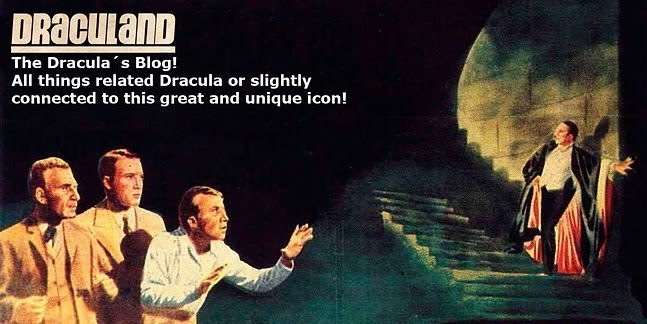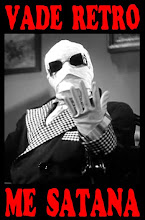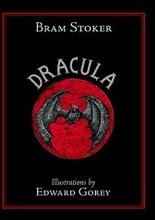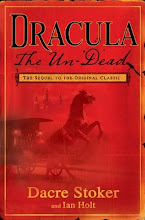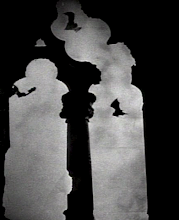
Dracula: Pages from a Virgin´s Diary is a 2002 horror film
directed by Guy Maddin. It is a silent interpretation of the Royal
Winnipeg Ballet´s take of Bram Stoker´s Dracula. It was
originaly filmed as a telefilm for CBC Television in Canada, but
critical and popular acclaim brought it to a United States
theatrical release.
"Bruce Diones in The New Yorker declared that
“Maddin has discovered a new kind of cinema, the
welding of silent-film technique, avant-garde imagery,
and 21st century technology....Victorian sexuality and
melodrama are brought together in a shadowy world
of expressionistic images and an athletic, almost rabid,
choreography.”
>>Plot:
In 1897, a visitor from the East, Dracula, arrives in London and is
inadvertenly invited into the home of Lucy. She is bitten by Dracula,
and taken by his curse. Lucy´s behavior becomes more erratic
leading her to bite her fiancée. Lucy is immediately put under the
care of Dr. Van Helsing. Van Helsing does blood tests on Lucy and
declares "Vampyre!" as the source of the problem, and puts Lucy
to bed adormed with garlic. That night, Renfield, a mental patient
who lives in the asylum next to Lucy´s mother awakens in the
commotion. Panicked by the demons, Lucy´s Mother opens the
door and inadvertenly re-invites Dracula into the house. Both
Lucy and her mother are killed in this incident and funeral
procession takes place. The next day, Renfield is recaptured and
placed back into the mental hospital. Bizarre incidents begin to
occur around the city with newspapers headlines proclaiming a
"Bloofer Lady" who has been murdering infants. Renfiled is
interrogated and confesses tha Dracula has brought Lucy back
from the dead commintting these deeds and the solution to the
problem lies in the graveyard. Van Helsing and Lucy´s suitors
go there and spy Dracula and the undead Lucy in a full romantic
embrace. After Dracula leaves, Van Helsing declares "We must
destroy the false Lucy so the real one may live forever".
When Van Helsing opens the Lucy´s coffin, Lucy rises out and
attacks the men. Lucy is eventually subdued by a piercing stab
from Jonathan´s long wooden stakes and decapitation with a
shovel by Van Helsing who then declares they must find and
defeat the Vampyre.
Van Helsing and his men go to ingterrogate Renfiled finding out tha
Dracula´s next plan is to attack Lucy´s best friend Mina. Menawhile,
Mina who is in a conevt aids her injured fiancée Harker. Renfiled
revels to Van Helsing of Harker´s journey to Castle Dracula where
Harker intented finalize a land sale. Upon arriving, harker is ravaged
by three Brides of Dracula who overpower him. Harker eventually
finalizes the land deal for Darcula, and gets placed in imprisonment
in his Castle. Harker escapes, finding himself under the care of the
convent´s inhabitants. Renfield explains thar Van Helsing should
seek past the Convent and towards Castle Dracula. in the covent,
Mina arrives to greet Harker. mina finds his diary, as Harker
cautiosly allows Mina to learn of his plaesures with the Brides of
Dracula be known to her. With what she has discovered about
Harker, Mina becomes becomes progressively more sexually
aggressive which Harker nervous as he flees with the diary.
Mina attempts to follow Harker but comes face to face with
Dracula, who kidnaps her takes her to Castle Dracula.
In Castle Dracula, Dracula woos Mina, tempting her with offers os
riches and eventually biting her on the neck, solidifying his curse on
her. Harker, Van Helsing, and his men break into Dracula´s castle
dispatch the Brides of Dracula with long wooden stakes. The men
eventually stumble upon Mina and find the mark of Dracula´s bite
upon her. Attempting to root out Dracula, the men smash coffins
and place Christian crosses in them. Dracula attacks the men.
After the battle, Dracula and Mina are the only two left conscious.
Mina scurries to a windows with a cross and pulls it open to have
sunlight which stuns Dracula. At this point the men regain
consciousness, surround Dracula, and stab him with their stakes.
The castle is demolished by Van Helsing´s men and everyone
departs. Dracula es left hanging motionless, impaled on a giant
stake.
Deviantions from the novel
>>Style:
Like most of Maddin´s films which are filmed in a style that
imitates aerly talkie films, Darcula, pages from a Virgin´s Diary
is shot in silent film tradition complete with title cards and some
mimicked special effects of the time such as tinted screen color,
shadow play, and vaseline on the camera lens to create a blurry
effect. The film is not entirely monochrome, often computer
generated special effects are used to allow bright, acidic colours
to be seen in normally black and white scenes, such as golden
coins, green bank notes and red blood in a otherwise
monochrome shot.
Unique to this film stylistically is that Dracula has an abundance
of ballet with nearly its entire cast being part of the Royal
Winnipeg Ballet. Large portions of this film are expressed the
medium.
The film also gently mocks or plays with some conventions of
the "Dracula" story. For example, Jonathan harker´s account
of his imprisonment in Dracula´s castle, wich takes up the
whole firts section of Bram Stoker´s novel, is relegated to a
single brief scene midway through the film. Presented at an
accelerated speed, as if shot with an old under-cranked camera,
the scene is punctuated with suggestive and humorous title
cards. Most notable is "infants for supper?" a mild, if
incredulous inquiry which stands in for the horror Jonathan
usually expresses when Dracula presents his brides with a bay
to eat.
>>Cast:
- Zhang Wei-Qiang - Dracula
- Tara Birtwhistle - Lucy Westenra
- David Moroni - Dr. Van Helsing
- CindyMarie Small - Mina
- Johnny Wright - Jonathan Harker
- Brent Neale - Renfield
>>Reception:
The film a limited theatrical release, but came to popular
critical acclaim with an 84% averange rating on Metacritic
and an 85% "Flesh" rating on Rotten Tomatoes. Roger
Ebert gave the film 31/2 stars out of 4, writing: "Dracula:
pages from a Virgin´s Diary" is not concerned with the
story mechanics of moving from A to B. At times it feels
almost like one of those old silent films where scenes have
gone missing and there are jumps in the chronology. This
is not a problem but an enhancement, creating for us the
sensation of glimpsing sntaches of a dream. So many
films are more or less alike that it´s jolting to see a film
that deals with a familiar story, but looks like no other.
>>Awards and nominations:
Festival de Cine de Sitges:
- Win: Best Film - Guy Maddin
International Emmy Awards:
- Win: Best Performing Arts Program - Canada
Directors Guild of Canada:
- Nominated: DGC Craft Award - Guy maddin
Blizzard Awards:
